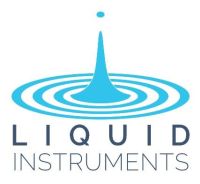
Discover Moku:Lab
Transform the way you do test and measurement with a suite of twelve professional-grade instruments that come included with every Moku:Lab.
One flexible hardware platform.
Twelve powerful instruments.
Moku:Lab is a software-configurable hardware platform for test and measurement that combines the signal processing power of an FPGA with high-speed analog inputs and outputs. Moku:Lab brings a new level of flexibility to the lab, the field, and on the production line.
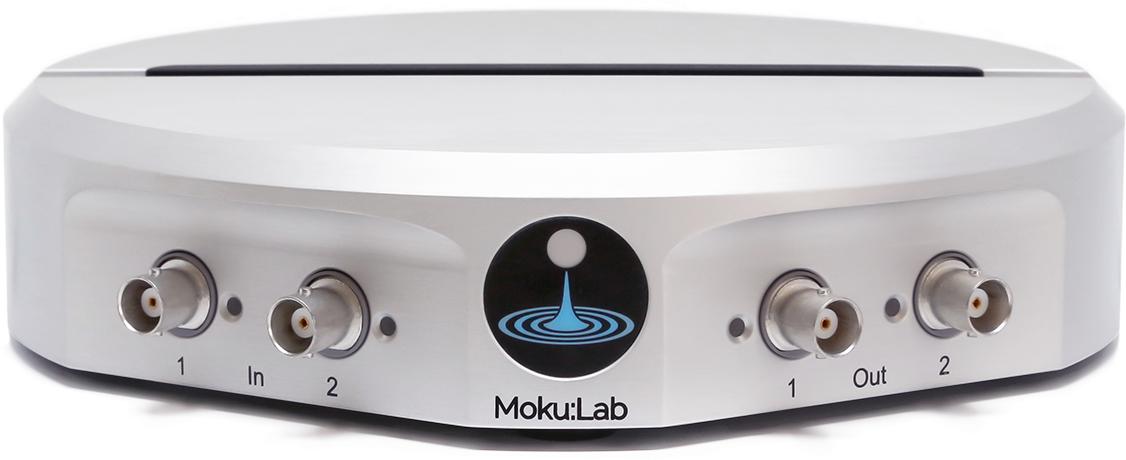

Lock-in Amplifier
PID Controller
Bode Analyzer
Laser Lock Box
Phasemeter
Oscilloscope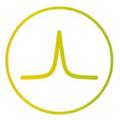
Spectrum Analyzer
Digital Filter Box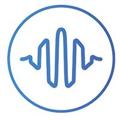
Arbitrary Waveform Generator
Waveform Generator
Data Logger
FIR Filter Builder
Lock-in Amplifier
Moku:Lab’s digital Lock-In Amplifier supports dual-phase demodulation (XY/RØ) from DC to 200 MHz with up to 100 dB of dynamic reserve. It also features an integrated 2-channel oscilloscope and data logger, enabling you to observe signals at up to 500 MSa/s and log data at up to 1 MSa/s.
Features
- Measure signals obscured by noise with more than 80 dB dynamic reserve
- Block diagram view of the digital signal processing chain
- Built-in probe points for signal monitoring and data logging
- Internal or external demodulation modes including a PLL (phase-locked loop)
- Dual-phase demodulation
- Toggle between rectangular (X/Y mode) or polar coordinates (R/Theta mode)
- Built-in PID Controller
Specifications
- Demodulate with frequencies ranging from 1 mHz to 200 MHz with 3.55 μHz resolution
- Phase shift precision of 0.001°
- Input gain: -20 dB / 0 dB / + 24 dB / + 48 dB
- 50 Ω / 1 MΩ input impedance
- Adjustable time constant from 40 ns to 0.6 s
- 6 or 12 dB/octave filter roll-off
- Output gain range: ± 80 dB
- LO output up to 200 MHz with variable amplitude
- Ultra-fast data acquisition: snapshot mode up to 500 MS/s, continuous mode up to 1 MS/s
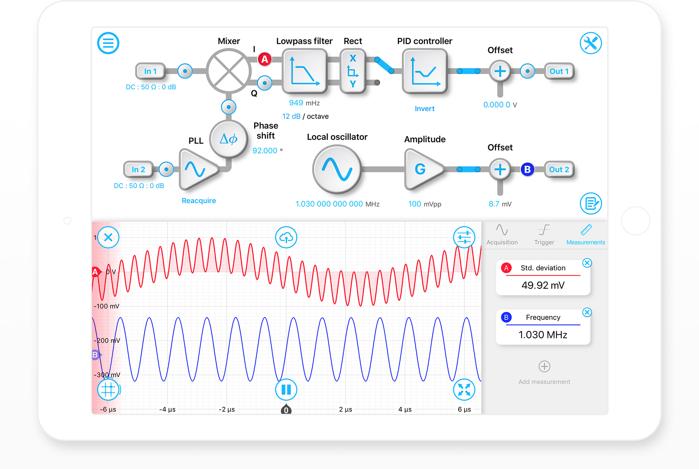
PID Controller
Moku:Lab’s PID Controller features two fully configurable PID controllers with an output sample rate of 10 MSa/s. This enables them to be used in applications requiring both low and high feedback bandwidths such as temperature and laser frequency stabilization. The PID Controller can also be used as a lead-lag compensator by saturating the integral and differential controllers with independent gain settings.
Features
|
Specifications
|
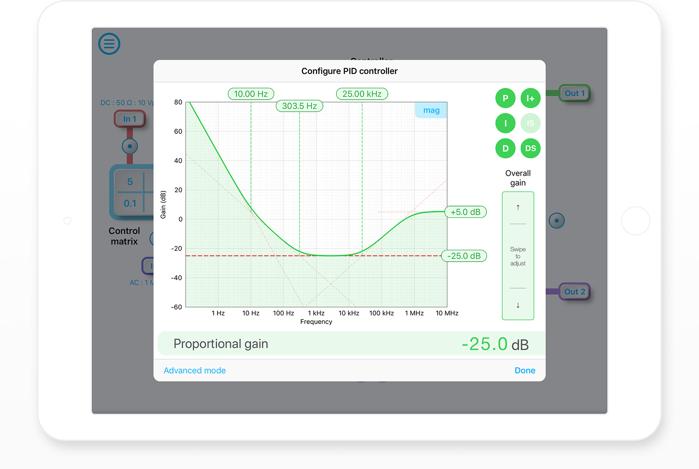
Bode Analyzer
Moku:Lab’s Bode Analyzer can be used to measure a system’s frequency response from 10 mHz up to 120 MHz.
Features
- Linear or logarithmic swept sine output
- Probe two systems simultaneously, or one system at two points
- Math channel to add, subtract, multiply or divide response functions as they are acquired
- Monitor the magnitude and phase on the interactive Bode plot
- Use cursors and markers to measure exact values on the plots
- Precisely adjust settling and averaging time to suit device under test
- Save a calibration trace to compare systems or remove spurious cable shifts
- Easily save data and upload to the cloud
Specifications
- Frequency range: 10 mHz to 120 MHz
- 50 Ω / 1 MΩ input impedance
- Variable averaging time (1 µs - 10 s)
- Variable settling time (1 µs - 10 s)
- Linear/logarithmic sweep
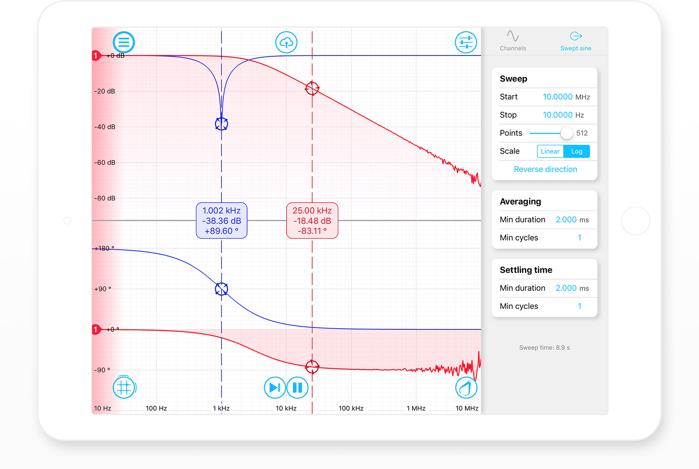
Laser Lock Box
Moku:Lab’s Laser Lock Box enables you to stabilize a laser's frequency to a reference cavity or atomic transition using high-performance modulation locking techniques. The Laser Lock Box includes a ‘Tap-to-Lock’ feature, enabling you to quickly lock to any zero-crossing on the demodulated error signal. It also features an integrated 2-channel oscilloscope, allowing you to observe signals at any point in the signal processing chain at up to 500 MSa/s.
Features
- Block diagram view of the signal processing chain
- Demodulate signals with internal or external local oscillators
- Scan resonances with sawtooth or triangle waveforms
- Observe signals at different locations in the signal processing chain using an integrated oscilloscope
- Quickly lock to any zero-crossing in the error signal using the ‘Tap-to-Lock’ feature
- Low-pass filter demodulated signals with up to fourth order infinite-impulse response filters
- Individually configure high- and low-bandwidth PID controllers for fast and slow feedback
- Observe signals with respect to the scanning voltage using the ‘Scope-Scan Lock’ feature
Specifications
- Local oscillator frequency: 1 mHz to 200 MHz (3.55 µHz resolution)
- Scan waveforms: positive sawtooth, negative sawtooth, triangle
- Scan frequency: 1 mHz to 1 MHz
- Low-pass filter corner frequency: 1 kHz to 14 MHz
- 6 dB / 12 dB per octave filter roll-off
- Low-pass filter types: Butterworth, Chebyshev, Inverse Chebyshev, Elliptic, Gaussian, Bessel, Legendre
- AC / DC coupling
- 50 Ω / 1 MΩ input impedance
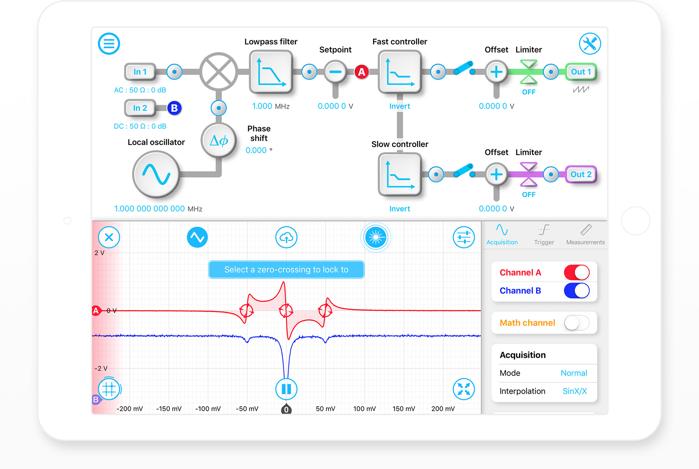
Phasemeter
Moku:Lab’s Phasemeter measures phase of up to two input signals with better than 6 µradian precision from 1 kHz up to 200 MHz. Based on a digitally implemented phase-locked loop architecture, Moku:Lab’s phasemeter provides exceptional dynamic range, zero dead-time and measurement precision that exceeds the performance of conventional lock-in amplifiers and frequency counters.
Features
- Track and record the phase, frequency and amplitude of two independent signals
- Phase-locked loop tracking bandwidths from 10 Hz (great for tracking low SNR signals) up to 10 kHz (ideal for signals with large dynamics)
- Real-time spectral analysis to display and save Power Spectral Densities, Amplitude Spectral Densities, Allan Deviation and more
- Free-wheeling mode intelligently holds the loop state when the signal fades unexpectedly and automatically re-engages when it returns
- Phase-locked output option enables you to generate sine waves that are phase-locked to the inputs
>
Specifications
- Input frequency range: 1 kHz – 200 MHz (auto-acquire or manually specify)
- Frequency set-point precision: 3.55 µHz
- Tracking bandwidth: 10 Hz, 40 Hz, 150 Hz, 600 Hz, 2.5 kHz, 10 kHz
- Frequency precision up to 10 µHz/√Hz
- Phase precision up to 100 nanocycles /√Hz
- Data logging rates: 30.5 Hz, 122 Hz, 488 Hz, 1.95 kHz, 15.6 kHz, 125 kHz
- Dual channel 250 MHz sine wave generators (manual or input-locked)
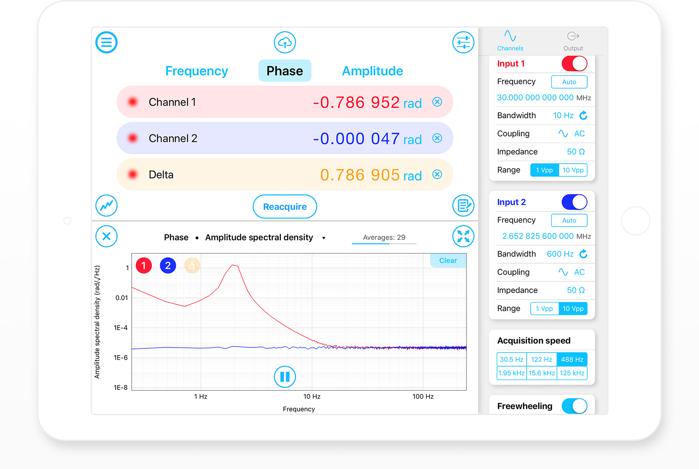
Oscilloscope
Moku:Lab’s Oscilloscope features two 500 MS/s analog input channels with 200 MHz analog bandwidth, 10 Vpp input voltage range, and user-configurable AC / DC coupling and 50 Ω / 1 MΩ impedance. The Oscilloscope also features two integrated waveform generators capable of producing sine waves at up to 250 MHz and square, sawtooth and triangle waves at up to 100 MHz, enabling it to stimulate a system and measure it’s response simultaneously.
Features
- Two analog inputs with 200 MHz bandwidth
- Built-in two-channel 250 MHz waveform generator
- Visualization tools including measurement trends and histograms
- TTL-compatible external trigger
- Wireless or wired interface to iPad, Python, MATLAB and LabVIEW
- Math channel with support for arbitrary functions
Specifications
- < 30 nV/√Hz above 100 kHz at 1 Vpp input range
- Vertical resolution of 12 bits at 500 MS/s up to 22 bits at 1 kS/s
- Switchable AC/DC coupling and 50Ω/1MΩ input impedance
- Over 20 waveform measurements
- Linear, Sinc, and Gaussian interpolation
Intutive Shortcuts
- Multitouch interface: Intuitively adjust time and voltage levels with pan and pinch gestures
- Save data: Single tap data uploading to the Cloud, email or SD card
Even More
- Cursors abound: Show up to 5 cursors on each channel and on the horizontal axis. Each one can be set as a reference or pinned to the waveform.
- Histograms: Display live, full frame rate histograms, useful for diagnosing sources of error such as electronic crosstalk
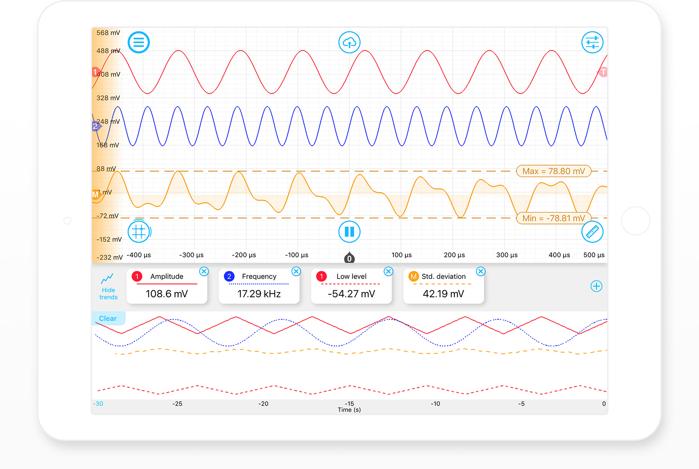
Spectrum Analyzer
Moku:Lab’s Spectrum Analyzer allows you to observe input signals in the frequency domain between DC and 250 MHz. View two channels of data simultaneously with a resolution bandwidth as low as 1 Hz over a minimum span of 100 Hz. The Spectrum Analyzer also features two integrated waveform generators capable of producing sine waves at up to 250 MHz.
Features
- Display and record power spectra or power spectral densities in the frequency domain from DC to 250 MHz
- Quickly measure key metrics by dragging measurement cursors onto features of interest using the iPad’s multi-touch interface
- Additional display settings: Video bandwidth filtering, Averaging, Persistence
- Generate two sine waves up to 250 MHz using Moku:Lab’s built-in analog outputs
Specifications
- Frequency Range: DC to 250 MHz
- Frequency Span: 1 kHz to 250 MHz
- Resolution Bandwidth (RBW) modes: Auto, Manual, or Min
- Minimum RBW: 1 Hz
- RBW Windows: Blackman-Harris, Flat top, Hanning, None
- Dual channel sine-wave generator frequency range: 1 mHz to 250 MHz
Measurements, and more
The multitouch user interface really shines with Moku:SpectrumAnalyzer. No need to wrestle with frequency range settings and start/ stop/ span inconsistencies. The Spectrum Analyzer features a frequency range of 200 MHz (extended to 250 MHz in software) and resolution bandwidths down to 1 Hz, all with super fast update rates thanks to the DSP power of Moku:Lab’s FPGA.
Moku:SpectrumAnalyzer inherits the best features from Moku:Oscilloscope: tracking cursors, averaging, persistence and, of course, simple sharing of data via DropBox, iCloud and email. A math channel in Moku:SpectrumAnalyzer includes options to display Max Hold or Min Hold data of a channel. You can display your data with a log or linear power spectrum or power spectral density or even visualize the evolution of spectra with 3D waterfall plots.
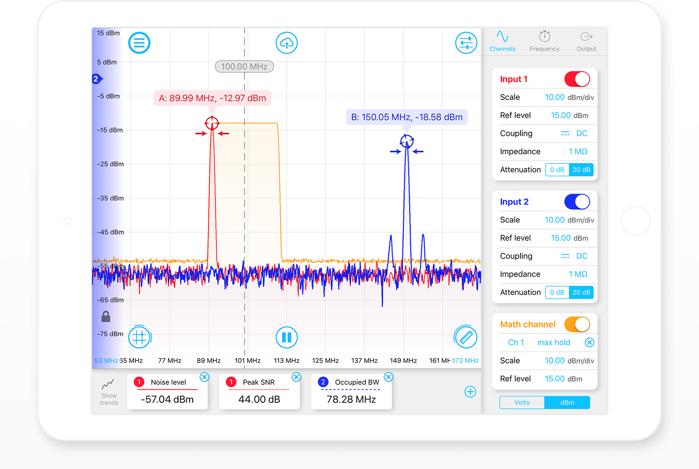
Digital Filter Box
With Moku:Lab’s Digital Filter Box, you can interactively design and generate different types of infinite impulse response filters with output sampling rates of 122 kHz and 15.625 MHz. Select between lowpass, highpass, bandpass and bandstop filter shapes with up to seven fully configurable types including Butterworth, Chebyshev and Elliptical.
Features
- Design your filter's frequency response using the interactive Bode plot
- Block diagram view of the digital signal processing with built-in probe points for signal monitoring
- 2 input channels, 2 output channels with optional blending for MIMO systems
- Supports custom filter designs
Specifications
- Filter presets: Lowpass, Highpass, Bandpass, Bandstop; Butterworth, Chebyshev I, Chebyshev II, Elliptic, Bessel, Gaussian and Legendre
- Sub-microsecond input-output latency
- 1 Hz – 6 MHz corner frequencies
- 0.1 – 10 dB configurable passband ripple
- 10 – 100 dB configurable stopband attenuation
- 2nd – 8th order filters
- 50 Ω or 1 MΩ input impedance
- Independently adjustable input and output offsets and gain
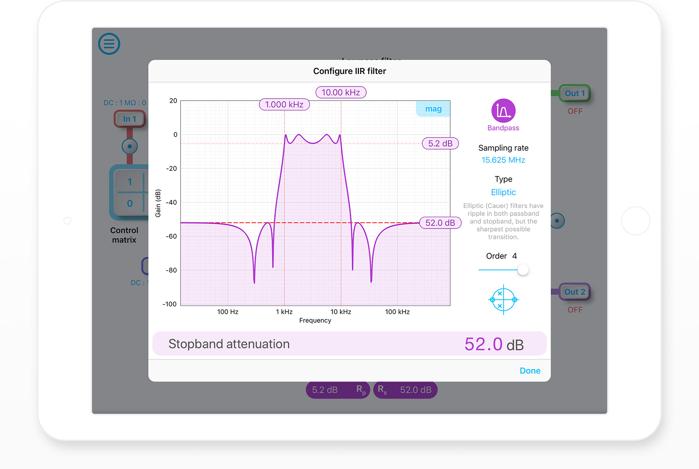
Arbitrary Waveform Generator
Moku:Lab’s Arbitrary Waveform Generator can generate custom waveforms with up to 65,536 points at sample rates of up to 1 GSa/s. Waveforms can be loaded from a file, or input as a piece-wise mathematical function with up to 32 segments, enabling you to generate truly arbitrary waveforms. In pulsed mode, waveforms can be output with more than 250,000 cycles of dead time between pulses, allowing you to excite your system with an arbitrary waveform at regular intervals over extended periods of time.
Features
- Choose between one of the preset waveforms, load points from a file or input an equation directly
- Configure pulsed output with up to 250,000 cycles of dead time between pulses
- Phase-synchronized output between the two channels
Specifications
- Custom waveforms with up to 65,536 points at 125 MS/s (up to 8192 waveform points at 1 GS/s)
- Preset waveforms: Sine, Gaussian, Exponential Rise, Exponential Fall, Sinc
- 1 mHz – 125 MHz output frequency
- Equation mode with up to 32 segments
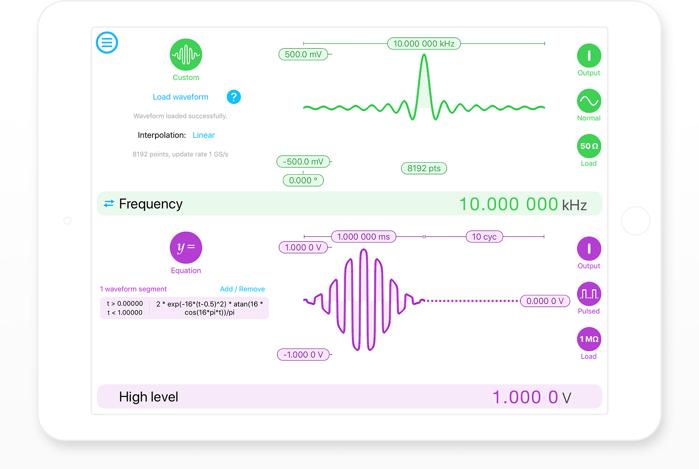
Waveform Generator
Moku:Lab’s Waveform Generator enables users to generate two independent waveforms with a sampling rate of 1 GSa/s, a maximum frequency of 250 MHz and a output voltage range of ± 1 V into 50 Ω. Select between sine, square, ramp, pulsed or DC waveform shapes. Modulate the phase, frequency or amplitude, or generate triggered bursts or sweeps from an internal or external source.
Features
- Generate 2 independent waveforms from DC to 250 MHz
- Wideband modulation (AM, FM, and PM) from internal or external source
- Triggered burst and sweep modes
- Synchronize via 10 MHz input/output
- Powerful and flexible waveform triggering options
- iPad, Python, MATLAB and LabVIEW control
Specifications
- Analog output bandwidth 300 MHz
- Modulation bandwidth 62.5 MHz
- SFDR > 50 dBc for frequencies below 20 MHz
- Total harmonic distortion < 0.1% (1.5 MHz, 5 harmonics)
- 2 Vpp output into a 50 Ω load
- < 1 ppm oscillator stability
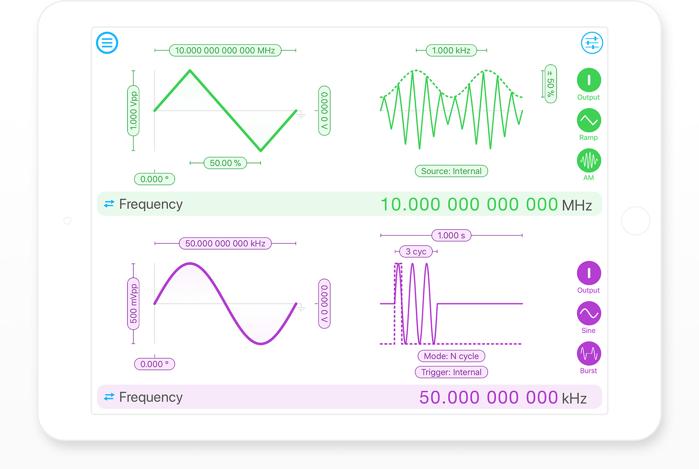
Data Logger
Moku:Lab’s Data Logger enables you to log data directly to an SD card for long-term measurements at rates of up to 100 kS/s, where the duration is limited only by the capacity of the SD card. Data can also be acquired at up to 1 MS/s by saving directly to Moku:Lab’s internal memory. Data saved to Moku:Lab’s internal memory can be uploaded to the cloud for analysis once the measurement is complete.
Features
- Log voltage data on two independent channels to an SD card for long-term measurements, or directly to Moku:Lab’s internal RAM for short, high-speed bursts
- Built-in two-channel 250 MHz waveform generators
- File formats: Plain text (csv) or binary, depending on data acquisition rate
- Export modes: SD card, Dropbox, Email, iCloud, or the iPad “My Files” folder
- Schedule a log to start after a delay of up to 10 days
Specifications
- Log at up to 100 kS/s to an SD card, up to the card’s capacity (16 GB SD card included)
- Log at up to 1 MS/s directly to Moku:Lab’s internal memory (500 MB RAM)
- Input voltage range: 1 Vpp or 10 Vpp
- Input impedance: 50 Ω or 1 MΩ
- Input coupling: AC or DC
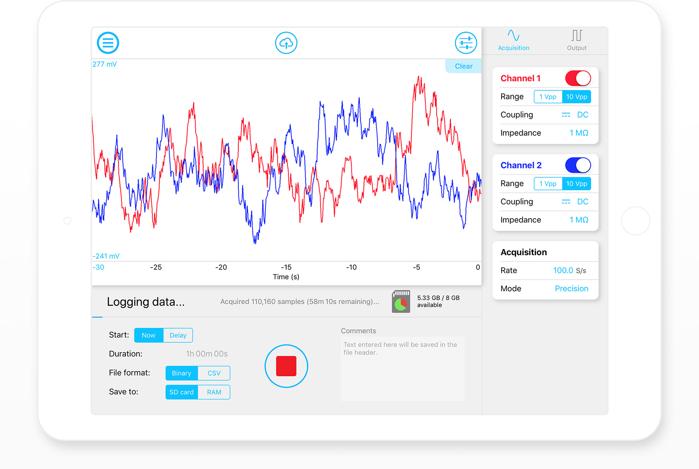
FIR Filter Builder
With Moku:Lab’s FIR Filter Builder, you can design and implement lowpass, highpass, bandpass, and bandstop finite impulse response (FIR) filters with up to 14,819 coefficients at a sampling rate of 244.1 kHz. Moku:Lab’s iPad interface allows you to fine tune your filter’s response in the frequency and time domains to suit your specific application. Select between four frequency response shapes, five common impulse responses, and up to eight window functions.
Features
- Design filters in the time domain or in the frequency domain, choosing from common impulse responses and window functions
- Load your own filter coefficients or enter an equation to create a customized impulse response
- Visualize the filter's transfer function, impulse and step response, or group and phase delay
- Easily save data and upload to the cloud
Specifications
- 2 independent channels
- Up to 15 MS/s sampling rate with 232 coefficients
- Over 14,000 coefficients at 244 kS/s
- Filter coefficient precision of up to 24 bits
- Preset frequency response shapes: Lowpass, Highpass, Bandpass, Bandstop
- Window functions: Bartlett, Hanning, Hamming, Blackman, Nuttall, Tukey, Kaiser, or None
- AC / DC input coupling
- 50 Ω / 1 MΩ input impedance
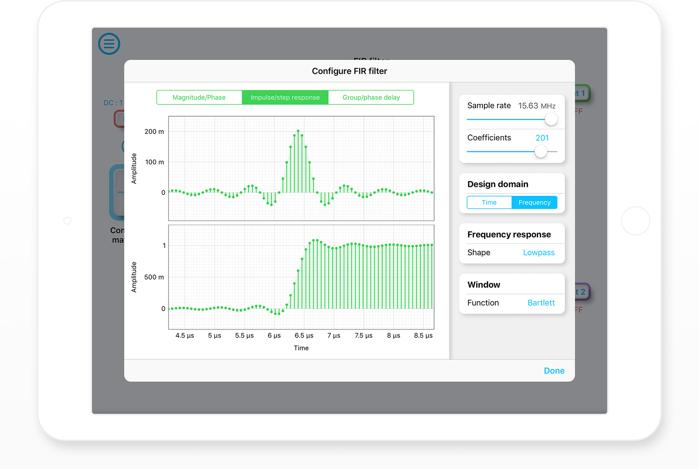
Contact

Tobias Heider
This email address is being protected from spambots. You need JavaScript enabled to view it.
Tel: +49-(0)89-818 90 781
Mobile: +49-(0)151-227 95 965




 Optoprim France
Optoprim France Optoprim Italy
Optoprim Italy